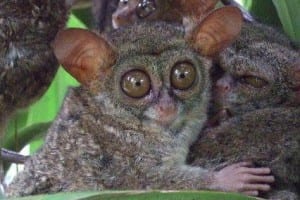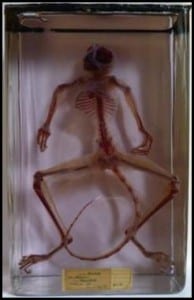Specimen of the Week: Week Twenty-One
By Emma-Louise Nicholls, on 5 March 2012
 There was evidently a lot of love in the Grant Museum over the half-term period as specimen adoptions went through the roof. The number of new adoptive parents numbered well into double figures. It was a particularly superb week for one particular primate, with three of our five specimens of the species now no longer orphans. To celebrate, they asked me to make them animal of the week. When I informed them that the blog was called Specimen of the week, they elected a representative. Such excellent teamwork skills for such a mini-mammal. So, by popular tiny primate demand, this week’s specimen of the week is:
There was evidently a lot of love in the Grant Museum over the half-term period as specimen adoptions went through the roof. The number of new adoptive parents numbered well into double figures. It was a particularly superb week for one particular primate, with three of our five specimens of the species now no longer orphans. To celebrate, they asked me to make them animal of the week. When I informed them that the blog was called Specimen of the week, they elected a representative. Such excellent teamwork skills for such a mini-mammal. So, by popular tiny primate demand, this week’s specimen of the week is:
**!!!The Tarsier!!!**
1) The first thing to say about tarsiers is that they are darn cute, podgey, big-eyed, furry, cuddly things. Hence my inability to argue with them. I’m not weak; could you argue with this face –> (I’m not speaking for his evil twin on the right). They have the owl-like ability to rotate their heads almost 180° in both directions, giving a near 360° view of their surroundings.
2) Despite being cute and cuddly with eyes to shame Puss in Boots, tarsiers are the only primate on the planet to be completely carnivorous. That’s right. Not so cute now are they.
3) Tarsiers have a large number of bones in their heel that are relatively much longer than in the skeleton of any other primate. These foot bones, as with your foot bones, are called tarsals. The tarsier’s spectacular tarsals aid their leaping. So why are these primates called ‘tarsiers’? That was rhetorical.
4) The tarsiers’ tarsals (get it yet?) have evolved to enable them to leap great distances. The Horsfield’s tarsier has been recorded leaping over 5 m in a single jump. Not bad for an animal that weighs 1/3 of a can of beer.
5) “Why is your tarsier red?” you may be thinking. This tarsier has been cleared and then stained with alizarin which turns any material containing calcium red. The staining abilities of alizarin for medical purposes was first discovered in the 1500’s by scientists who fed it to animals and were excited by the subsequent red staining of their teeth and bones. Historically, alizarin was an organic compound, though in the 1800’s it became the first natural pigment to be reproduced using synthetic materials.
Before you go off weighing beer cans to divide by three, pop in to the Museum and see if you can find all of our tarsiers. Despite being sociable creatures, they are quite widespread so it would be a good treasure hunt.
2 Responses to “Specimen of the Week: Week Twenty-One”
- 1
-
2
Ivan Sandvall wrote on 18 March 2012:
Hi! My name is Ivan and I’m 7. My favourite animal is the Tarsier.
Tarsiers have sticky pads on their hands and their eyes are bigger then their own brain. They can leap huge distances and have razor-sharp teeth to crunch through their pray. That’s why I like them.
When I came to your museum in the school holidays, I was delighted to see a tarsier skeleton. It was the first tarsier skeleton I had ever seen!!! I was super inspired. I have made a drawing of your tarsier skeleton. It is very good. Do you want a photo of it?
 Close
Close





Tarsier fans might wish to check their IUCN status here – http://www.iucnredlist.org/apps/redlist/details/21491/0
It seems it was named by the German scientist Johann Christian Polycarp Erxleben (1744-1777), founder of modern veterinary science in Germany – a great name!
Also there is a tarsier website with an article on the taxonomic history which seems to be freely available and has some nice pictures showing the differences in the skulls of different species-
http://www.tarsier.org/products_files/2008-POTON-p1-Grovesetal-TaxonomicHistory.pdf